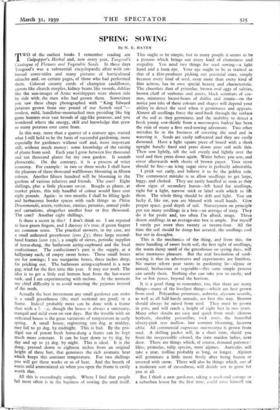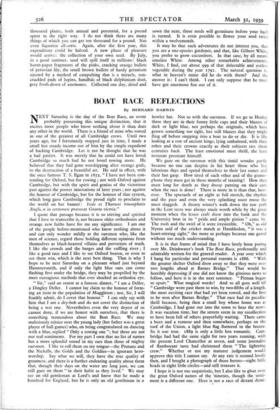SPRING SOWING
By H. E. BATES
TWO of the earliest books I remember reading are Culpepper's Herbal and, new every year, Toogood's Catalogue of Flowers and Vegetable Seeds. In those days Toogood's was a substantial encyclopaedic affair with em- bossed cover-titles and many pictures of horticultural miracles and, on certain pages, of those who had performed them. Colossal creamy curds of champion cauliflower, carrots like church steeples, kidney beans like swords, dahlias like the sun-images of Aztec worshippers were shown side by side with, the men who had grown them. Sometimes you saw these chaps photographed with " King Edward potatoes grown from one pound of our Scotch seed "- modest, mild, handlebar-moustached men presiding like big game hunters over vast broods of egg-like potatoes, and you wondered where the energy, skill and knowledge that grew so many potatoes ever came from.
In this way, more than a quarter of a century ago, started what I still hold to be the basis of successful gardening, more especially for gardeners without staff and, more important still, without much money : some knowledge of the raising of plants from seed. Each year I grow between five thousand and ten thousand plants for my own garden. It sounds plutocratic. On the contrary, it is a process of strict economy. For example : in two or three weeks I shall have the pleasure of three thousand wallflowers blooming in fifteen colours. Another fifteen hundred will be blooming in the gardens of various relatives and friends. The cost? Eight shillings, plus a little pleasant sweat. Bought as plants, at market prices, this tidy handful of colour would have cost eight pounds. Again: in two months I shall be filling laeds and herbaceous border spaces with such things as Phlox Drummondii, asters, verbenas, zinnias, petunias, annual pinks and carnations, altogether another four or five thousand. The cost? Another eight shillings.
Is there a secret in this? I don't think so. I am reputed to have green fingers, and I daresay it's true, if green fingers are common sense. The practical answers, in my case, are a small unheated greenhouse (cost L5), three large second- hand frames (cost t5s.), a couple of sieves, periodic supplies of horse-dung, the bathroom airing-cupboard and the local confectioner. The confectioner's part is the supply, at a halfpenny each, of empty sweet boxes. These small boxes are for sowings; I use margarine boxes, three inches deep, for pricking out. The bathroom airing-cupboard is a new gag, tried for the first time this year. It may not work. The idea is to get a little real bottom heat from the hot-water tank, and I am experimenting with melons. At the moment my chief difficulty is to avoid watering the pyjamas instead of the seeds.
Actually the best investment any small gardener can make is a small greenhouse (the steel sectional are good) or a frame. Indeed probably more can be done with a frame than with a h :se, though the house is always a sanctuary, tranquil and mild even on raw days. But the trouble with an unheated house is the great variations of temperature in early spring. A small house, registering too deg. at midday, may fall to 3o deg. by midnight. This is bad. By the pro- digal use of potent fresh horse-dung a frame can be kept much more constant. It can be kept down to 75 deg. by day and up to 55 deg. by night: This is ideal. It is the dung, pressed down to eighteen inches from an original height of three feet, that generates the rich aromatic heat which keeps this constant temperature. For two shillings you will get three weeks or so of heat. And the breath of warm mild ammoniated air when you open the frame is easily worth that.
All this is exceedingly simple. Where I find that people fall most often is in the bqsiness of sowing the seed itself. This ought to be simple, but to many people it seems to be a process which brings out every kind of clumsiness and stupidity. You need two things for seed sowing—a light hand and a keen eye. Your eye ought to be as trained as that of a film-producer picking out potential stars, simply because every kind of seed, even more than every kind of film actress, has its own special beauty and characteristic. The chocolate dust of primulae, brown oval eggs of salvias, brown chaff of verbenas and asters, black scimitars of cos- mos, miniature locust-beans of dahlia and zinnia—on the notice you take of these colours and shapes will depend your ability to detect the seed when it germinates and appears. Almost all seedlings force the seed-husk through the surface of the soil as they germinate, and the inability to detect a fresh young sow-thistle from a meconopsis baileyi has been the ruin of many a first seed-sowing adventure. Two other mistakes lie in the business of covering the seed and in watering it. Seeds are easily suffocated and they are easily drowned. Have a light square piece of board with a short upright handle fixed and press down your soil with this. Then sow lightly, sift the soil evenly and lightly over the seed and then press down again. Water before you sow, and cover afterwards with sheets of brown paper. Your sieve should be fine—an icing sugar sieve is perfectly admirable.
I prick out early, and believe it to be the golden rule. The commonest mistake is to allow seedlings to get large, leggy, and choked. They are easily handled as soon as they show signs of secondary leaves—left hand for seedlings, right for a light, narrow stick or label with which to lift them. The whole thing should be deft and light. You are lucky if, like me, you are blessed with small hands. Give proper space, good depth of soil. Nurserymen on principle put too many seedlings in a box—an average of sixty. They do it for profit and, too often I'm afraid, mugs. Three dozen seedlings in an average-size box is ample. For myself I rarely put more than twenty or twenty-four. All the time the soil should be damp but aerated, the seedlings cool but not in draughts.
This is the mechanics of the thing, and from this, the mere handling of sweet fresh soil, the first sight of seedlings, the warm damp smell of the greenhouse on spring days, will arise enormous pleasure. But the real fascination of seed- sowing is that its adventures and experiments are limitless. No matter where your tastes in gardening lie—alpine or annual, herbaceous or vegetable—this same simple process can satisfy them. Nothing else can take you so easily, and for so few pence, beyond the horizon.
It is a good thing to remember, too, that there are many things—many of the loveliest things—which are best grown from seed. Polyanthus primroses, aubretia, alyssum saxatile, as well as all half-hardy annuals, are best this way. Brooms should always be raised from seed. They must be grown in pots, and will reach a height of eight feet in two years. Many other shrubs are easy and quick from seed : chinese berberis, shrubby potentillas, rock roses, the beautiful silvery-pink tree mallow, late summer blooming, lavatera oblia. All commercial cupressus macrocarpa is grown from seed. A shilling packet will, in a short time, shield you from the irrepressible colonel, the irate maiden ladies, next door. There are things which, of course, demand patience : lilies, primulae, tulip species, most alpines. Auriculas will take a year, trollius probably as long, or longer. Alpines will germinate a little more freely after being frozen or covered with snow. There will also be things which, out of a moderate sort of cussedness, will decide not to grow for you at all.
But I think a new gardener, taking a week-end cottage or a suburban house for the first time, could raise himself ten thousand plants, both annual and perennial, for a pound spent in the right way. I do not think there are many things of which you can get ten thousand for a pound. Not even liquorice all-sorts. Again, after the first year, this expenditure could be halved. A new phase of pleasure would arrive: the collection of your own seed. By July, in a good summer, seed will spill itself in millions : black burnt-paper fragments of the pinks, cracking orange bullets of peruvian lily, the small brown bullets of hardy geranium ejected by a method of catapulting that is a miracle, sun- crackled pods of lupins, handfuls of black delphinium dust, grey froth-down of anemones. Collected one day, dried and sown the next, these seeds will germinate before your back is turned. It is even possible to flower your seed twice within a twelvemonth.
It may be that such adventures do not interest you, that you are a one-species gardener, and that, like Gilbert White, you prefer to grow cucumbers. In that case, by all means emulate White. Among other remarkable achievements, White, I find, cut about 999 of that delectable and useless vegetable during the year 1791. The natural question is, what in heaven's name did he do with them? And the answer is: I can't think. I can only suppose that he must have got enormous fun out of it.



































































 Previous page
Previous page